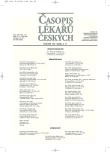Our First Experience with CT Enteroclysis
Naše první zkušenosti s CT enteroklýzou
Východisko.
Tenké střevo patří k obtížněji zobrazitelným orgánům dutiny břišní. Vyšetřovací metody a postupy se neustále zdokonalují ve snaze získat co nejlepší morfologický obraz střeva.
Metody a výsledky.
CT enteroklýza je moderní metoda zobrazení tenkého střeva, která kombinuje klasickou enteroklýzu a spirální CT břicha. Tenké střevo je vyplněno negativní kontrastní látkou, která je aplikována enterální sondou. Negativní kontrastní látka optimalizuje vizualizaci stěny střeva a zvláště pak jejího enhancementu po aplikaci jodové kontrastní látky intravenózně. Za 23 měsíců jsme CT enteroklýzou vyšetřili 33 pacientů, kteří byli indikováni gastroenterologem. V 31 případech bylo vyšetření technicky vyhovující, tenké střevo bylo dobře vyplněno negativní kontrastní látkou a dostatečně distendováno. Pacienty jsme rozdělili dle klinických indikací do 4 skupin: Skupina A: 10 pacientů indikovaných z rozpaků. V této skupině jsme nenalezli patologické změny na tenkém střevě. Skupina B: 8 pacientů s klinickým podezřením na Crohnovu nemoc. V této skupině byly pouze 2 nálezy negativní. V 6 případech byly nalezeny zánětlivé změny na tenkém či tlustém střevě. Skupina C: 6 pacientů po chirurgické intervenci pro Crohnově nemoci s podezřením na recidivu onemocnění. U všech pacientů jsme nalezli známky recidivy onemocnění. Skupina D: 7 pacientů bylo vyšetřeno z různých jiných klinických indikací. Ve dvou případech byl nález negativní, ale u 5 pacientů byly nalezeny patologické změny v oblasti střeva: 1x známky malabsorbce, 3x adheze a kýla, 1x zánět střeva s krytou perforací a mezikličkovým abscesem.
Závěry.
CT enteroklýza je metoda, kterou lze dosáhnout velmi kvalitního zobrazení tenkého střeva, lze posoudit i okolí střeva a celou dutinu břišní. Jde však o metodu, která je provázena radiační zátěží, zátěží z nitrožilního podání jodové kontrastní látky a z dyskomfortu ze zavedení enterální sondy. Z výše uvedených důvodů, by vyšetření nemělo být indikováno pouze z diagnostických rozpaků. Naopak, při řádné indikaci jsou patologické změny nalezeny ve vysokém procentu.
Klíčová slova:
CT enteroklýza, Crohnova nemoc, jodová kontrastní látka.
Authors:
Hana Malíková
; B. Míková
Authors‘ workplace:
Radiodiagnostické oddělení Nemocnice Na Homolce, Praha
Published in:
Čas. Lék. čes. 2006; 145: 879-883
Category:
Original Article
Overview
Background.
Small intestine belongs to abdominal organs which are difficult to imagine. Methods of examination have therefore continuously improved in order to get better picture of the intestine.
Methods and Results.
CT enteroclysis represents a modern method of the small intestine imagining which combines classical enteroclysis with spiral abdominal CT. Small intestine is filled with negative contrast material applied by an enteric tube. The negative contrast material optimises visualisation of the intestinal wall, namely after the enhancement using iodine intravenous contrast. Within 23 months we examined 33 patients with gastroenterological indication using CT enteroclysis. In 31 cases results were technically satisfactory, small intestine was well filled by the negative contrast material and sufficiently distended. According to clinical indications patients were classified into four groups. Group A: 10 patients with problematic indications. No pathological changes were found in this group. Group B: 8 patients suspected of Crohn’s disease. Only two cases were negative in this group. In 6 cases signs of inflammation in the small or large intestine were found. Group C: 6 patients after the surgical treatment of Crohn’s disease, suspected of the recurrence. All patients had signs of the recurrence. Group D: 7 patients with various clinical diagnoses. Examination was in 2 cases negative, in other 5 cases some pathological changes of the intestine were found: 1case of malabsorption, 3 cases of adhesion and hernia, 1 case of intestinal inflammation with covered perforation and inter-intestinal abscess.
Conclusions.
CT enteroclysis was confirmed to be effective method for high quality imaging of the small intestine with associated tissues and the whole abdominal cavity. However, it is a method with represent irradiation, stress of intravenous administration of the contrast material and the discomfort related to enteric tube. Examination should not be indicated in cases of the problematic diagnosis only. However, in cases of correct indication signs of pathology were frequently confirmed.
Key words:
CT enteroclysis, Crohn’s disease, iodine intravenous contrast.
Labels
Addictology Allergology and clinical immunology Angiology Audiology Clinical biochemistry Dermatology & STDs Paediatric gastroenterology Paediatric surgery Paediatric cardiology Paediatric neurology Paediatric ENT Paediatric psychiatry Paediatric rheumatology Diabetology Pharmacy Vascular surgery Pain management Dental HygienistArticle was published in
Journal of Czech Physicians

- Advances in the Treatment of Myasthenia Gravis on the Horizon
- Metamizole vs. Tramadol in Postoperative Analgesia
- Metamizole at a Glance and in Practice – Effective Non-Opioid Analgesic for All Ages
- Spasmolytic Effect of Metamizole
- The Importance of Hydration in Wound Healing
Most read in this issue
- Nicotinic Acid: An Unjustly Neglected Remedy
- Mean Platelet Volume (MPV) in Crohn’s Disease Patients
- Our First Experience with CT Enteroclysis
- Contemporary Non-invasive Aesthetic Medicine
